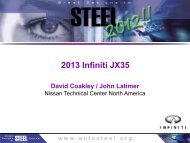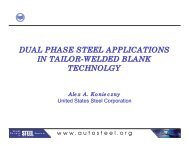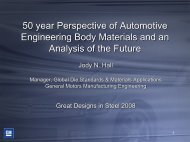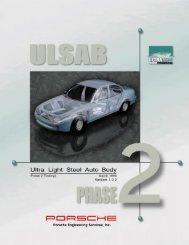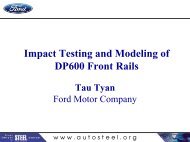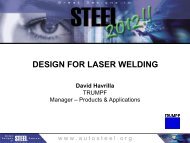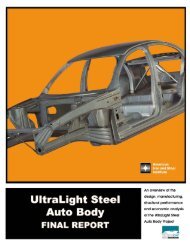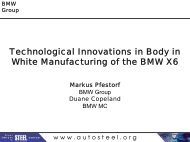Current Trends in Bumper Design for Pedestrian Impact
Current Trends in Bumper Design for Pedestrian Impact
Current Trends in Bumper Design for Pedestrian Impact
Create successful ePaper yourself
Turn your PDF publications into a flip-book with our unique Google optimized e-Paper software.
Leg<br />
to <strong>Bumper</strong><br />
Directive 2003/105/EC<br />
Knee bend<strong>in</strong>g < 21°<br />
Knee shear < 6 mm<br />
Tibia acceleration < 200 g<br />
Knee bend<strong>in</strong>g < 15°<br />
Knee shear < 6 mm<br />
Tibia acceleration < 150 g<br />
PEDESTRIAN LEG IMPACT TEST<br />
Upper Leg<br />
to Hood Edge<br />
Total load < 5 kN<br />
Bend<strong>in</strong>g moment < 300 Nm<br />
Head<br />
to Hood Top<br />
Directive 2003/105/EC Directive 2003/105/EC<br />
(Monitor Only) HPC < 1000 (2/3 of area)<br />
HPC < 2000 (1/3 of area)<br />
EuroNCAP EuroNCAP EuroNCAP<br />
A brief discussion of the pedestrian leg impact<br />
requirements will be helpful be<strong>for</strong>e proceed<strong>in</strong>g <strong>in</strong>to the<br />
design alternatives found <strong>in</strong> the literature. The purpose<br />
of the pedestrian leg impact test procedure is to reduce<br />
the occurrence of lower limb <strong>in</strong>juries <strong>in</strong> pedestrian<br />
accidents. In the pedestrian leg impact test, a ‘leg-<strong>for</strong>m’<br />
impactor is propelled toward a stationary vehicle at a<br />
velocity of 40 km/h parallel to the vehicle’s longitud<strong>in</strong>al<br />
axis. The test can be per<strong>for</strong>med at any location across<br />
the face of the vehicle, between the 30º bumper corners.<br />
The acceptance criteria are illustrated <strong>in</strong> Figure 2. The<br />
maximum tibia acceleration criterion is <strong>in</strong>tended to<br />
prevent tibia fractures. The knee bend angle and shear<br />
de<strong>for</strong>mation criteria are <strong>in</strong>tended to prevent knee jo<strong>in</strong>t<br />
<strong>in</strong>juries such as ligament ruptures and <strong>in</strong>tra-articular<br />
bone fractures.<br />
LIMITATIONS<br />
This study is a review the state-of-the-art (as of January<br />
2005) <strong>in</strong> the design of bumper systems <strong>for</strong> pedestrian<br />
impact. Because this task relies on work conducted<br />
primarily <strong>in</strong> Europe and Asia, markets with few light<br />
trucks, the design trends identified are based on<br />
passenger cars.<br />
Figure 1: <strong>Pedestrian</strong> impact test procedures<br />
HPC < 1000<br />
Acceleration Bend<strong>in</strong>g Shear<br />
( a < 150 g)<br />
o<br />
( α < 15 ) ( d < 6 mm)<br />
Figure 2: <strong>Pedestrian</strong> ‘leg-<strong>for</strong>m’ <strong>in</strong>jury criteria<br />
To focus the study, articles and patents were limited to<br />
those specifically describ<strong>in</strong>g bumper designs. Articles<br />
and patents deal<strong>in</strong>g with the follow<strong>in</strong>g were excluded:<br />
• Other areas of pedestrian impact analysis (e.g.<br />
head, torso, and thigh impacts, accident data<br />
analysis, impact k<strong>in</strong>ematics and biomechanics, test<br />
procedures, and computer simulations)<br />
α<br />
d



